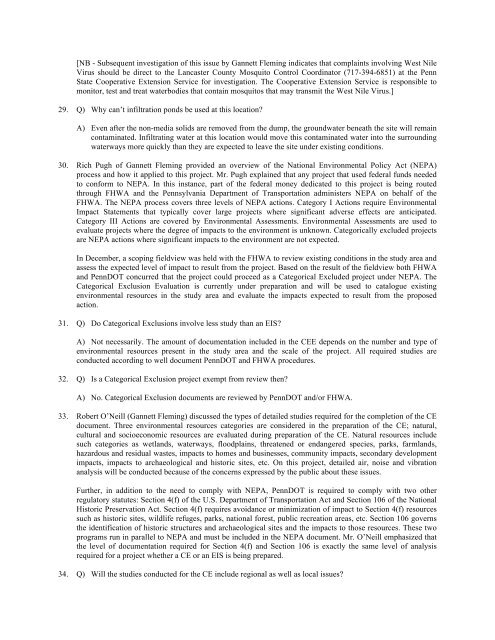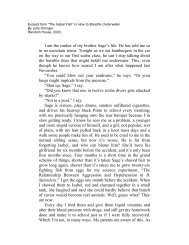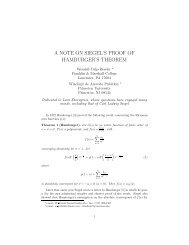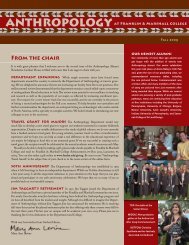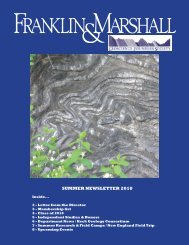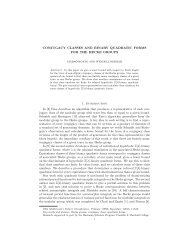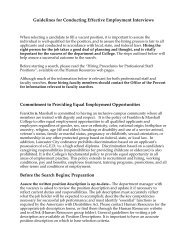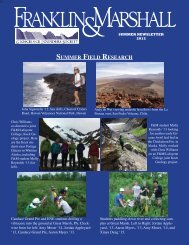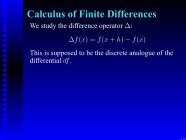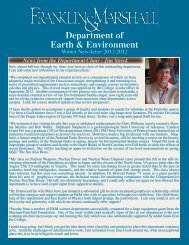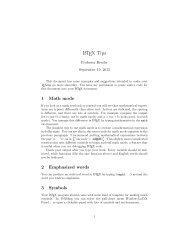norfolk southern dillerville yard consolidation project
norfolk southern dillerville yard consolidation project
norfolk southern dillerville yard consolidation project
- No tags were found...
You also want an ePaper? Increase the reach of your titles
YUMPU automatically turns print PDFs into web optimized ePapers that Google loves.
[NB - Subsequent investigation of this issue by Gannett Fleming indicates that complaints involving West NileVirus should be direct to the Lancaster County Mosquito Control Coordinator (717-394-6851) at the PennState Cooperative Extension Service for investigation. The Cooperative Extension Service is responsible tomonitor, test and treat waterbodies that contain mosquitos that may transmit the West Nile Virus.]29. Q) Why can’t infiltration ponds be used at this location?A) Even after the non-media solids are removed from the dump, the groundwater beneath the site will remaincontaminated. Infiltrating water at this location would move this contaminated water into the surroundingwaterways more quickly than they are expected to leave the site under existing conditions.30. Rich Pugh of Gannett Fleming provided an overview of the National Environmental Policy Act (NEPA)process and how it applied to this <strong>project</strong>. Mr. Pugh explained that any <strong>project</strong> that used federal funds neededto conform to NEPA. In this instance, part of the federal money dedicated to this <strong>project</strong> is being routedthrough FHWA and the Pennsylvania Department of Transportation administers NEPA on behalf of theFHWA. The NEPA process covers three levels of NEPA actions. Category I Actions require EnvironmentalImpact Statements that typically cover large <strong>project</strong>s where significant adverse effects are anticipated.Category III Actions are covered by Environmental Assessments. Environmental Assessments are used toevaluate <strong>project</strong>s where the degree of impacts to the environment is unknown. Categorically excluded <strong>project</strong>sare NEPA actions where significant impacts to the environment are not expected.In December, a scoping fieldview was held with the FHWA to review existing conditions in the study area andassess the expected level of impact to result from the <strong>project</strong>. Based on the result of the fieldview both FHWAand PennDOT concurred that the <strong>project</strong> could proceed as a Categorical Excluded <strong>project</strong> under NEPA. TheCategorical Exclusion Evaluation is currently under preparation and will be used to catalogue existingenvironmental resources in the study area and evaluate the impacts expected to result from the proposedaction.31. Q) Do Categorical Exclusions involve less study than an EIS?A) Not necessarily. The amount of documentation included in the CEE depends on the number and type ofenvironmental resources present in the study area and the scale of the <strong>project</strong>. All required studies areconducted according to well document PennDOT and FHWA procedures.32. Q) Is a Categorical Exclusion <strong>project</strong> exempt from review then?A) No. Categorical Exclusion documents are reviewed by PennDOT and/or FHWA.33. Robert O’Neill (Gannett Fleming) discussed the types of detailed studies required for the completion of the CEdocument. Three environmental resources categories are considered in the preparation of the CE; natural,cultural and socioeconomic resources are evaluated during preparation of the CE. Natural resources includesuch categories as wetlands, waterways, floodplains, threatened or endangered species, parks, farmlands,hazardous and residual wastes, impacts to homes and businesses, community impacts, secondary developmentimpacts, impacts to archaeological and historic sites, etc. On this <strong>project</strong>, detailed air, noise and vibrationanalysis will be conducted because of the concerns expressed by the public about these issues.Further, in addition to the need to comply with NEPA, PennDOT is required to comply with two otherregulatory statutes: Section 4(f) of the U.S. Department of Transportation Act and Section 106 of the NationalHistoric Preservation Act. Section 4(f) requires avoidance or minimization of impact to Section 4(f) resourcessuch as historic sites, wildlife refuges, parks, national forest, public recreation areas, etc. Section 106 governsthe identification of historic structures and archaeological sites and the impacts to those resources. These twoprograms run in parallel to NEPA and must be included in the NEPA document. Mr. O’Neill emphasized thatthe level of documentation required for Section 4(f) and Section 106 is exactly the same level of analysisrequired for a <strong>project</strong> whether a CE or an EIS is being prepared.34. Q) Will the studies conducted for the CE include regional as well as local issues?


